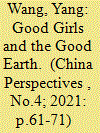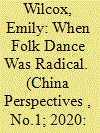| Srl | Item |
| 1 |
ID:
182944


|
|
|
|
|
| Summary/Abstract |
During the most robust years of his career, 1949 to 1964, the artist Shi Lu 石魯 (1919-1982) frequently painted young rural women. The appearance of peasant women in the art of the early Maoist period ostensibly demonstrates the suitability of the subject for visualising state policies that promoted social transformation and women’s liberation. While participating in these nation-building efforts, Shi Lu’s images of peasant women were also a product of global art historical influences, namely allegorical depictions, that manifested subtle influence on the development of twentieth-century Chinese art. The identity of the artist, a Yan’an cadre who provided creative and administrative support to the official art system, reveals how artists navigated political expectations as state functionaries while simultaneously defining them through artistic exploration. Through the case study of Shi Lu and the hybridised global artistic traditions that gave rise to the subject of young peasant women in Maoist China, this article reveals the porousness of an era that has been considered isolated from global currents outside of the Soviet sphere.
|
|
|
|
|
|
|
|
|
|
|
|
|
|
|
|
| 2 |
ID:
172997


|
|
|
|
|
| Summary/Abstract |
This article challenges three common assumptions about Chinese socialist-era dance culture: first, that Mao-era dance rarely circulated internationally and was disconnected from international dance trends; second, that the yangge movement lost momentum in the early years of the People’s Republic of China (PRC); and, third, that the political significance of socialist dance lies in content rather than form. This essay looks at the transformation of wartime yangge into PRC folk dance during the 1950s and 1960s and traces the international circulation of these new dance styles in two contexts: the World Festivals of Youth and Students in Eastern Europe, and the schools, unions, and clan associations of overseas Chinese communities in Hong Kong, Singapore, Malaysia, and San Francisco. By tracing the emergence and circulation of yangge and PRC folk dance, I propose the existence of “Cold War yangge” – a transnational phenomenon in which Chinese folk dance became a site of leftist political activism.
|
|
|
|
|
|
|
|
|
|
|
|
|
|
|
|